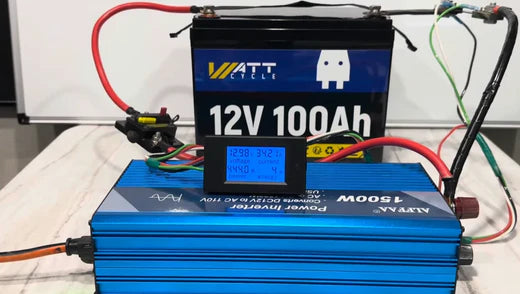
WattCycle 12V 100Ah LiFePO4 Battery: Reliable Performance at an Affordable Price
Youtube Reviewer: @THE OFF-GRID MOUNTAIN HOMESTEAD
When you're looking for a battery that offers stable performance at an affordable price, WattCycle's 12V 100Ah LiFePO4 (lithium iron phosphate) battery is undoubtedly a great choice. The reviewer conducted a series of rigorous tests to verify its performance under various conditions, and here are his findings:

Unboxing | What you will get
- A battery;
- A nice user manual;
- Some Screws;

Tech Specs Quick View:

Alpha Inverter + RPS Well Pump + DC Power Supply + Two Battery Chargers + Converter + Energy Meter + Hair Dryer + Ice/Ice Pack
Test 1: Capacity Test:
1) Charge the Battery:
Increase the charger's output slightly to ensure the battery is fully charged, indicated by no more current going into the battery.
2) Setup for Testing:
-Connect the battery to the inverter and energy meter.
-Ensure sampling shunt power leads are properly connected to the display to monitor the power accurately.
3) Initiate the Test:
-Turn on the alpha inverter.
-Plug in the load to the inverter.
-Begin the test, noting that the current drawn is slightly higher than usual.
This setup ensures a controlled environment to accurately measure the battery's performance under load.

Test 2: Load a RSP well Pump
1)Initial Setup:
- Connect the DC power supply to the RPS well pump.
- Note the current draw: 440 watts and 34 amps.
- Leave the system running for a few hours.
2)Full Power Pull Test:
- Use four Windy Nation cables and a Renogy shunt to connect the resistive load.
- Plan to draw 125 to 130 amps for 10 minutes.
- Turn on the inverter and ensure the battery is fully charged.
- Start the 10-minute test, drawing around 126 to 128 amps.
- After 10 minutes, check the battery performance, confirming it handled the load well.
3)Water Pumping Test:
- Pump approximately 120 gallons of water.
- Note the energy consumption: 1154 watt-hours to pump 120 gallons.
4)Final Discharge Test:
- Find additional loads to fully discharge the battery.
- Use two battery chargers to draw around 30 amps, matching the water pump's previous load.
- Continue discharging until the inverter shuts off at 1327 watt-hours.
- The WattCycle battery delivered 1327 watt-hours, demonstrating over 103 amp-hours of capacity, indicating a slightly higher than rated performance.
This process thoroughly tests the battery's performance, capacity, and the effectiveness of its Battery Management System (BMS).

Test 3: Tear Down & BMS Protection Test
Here is a concise summary of the teardown and testing process described:
1)Initial Inspection:
- Open the battery to examine the internal build quality.
- Observe large wires: two number eight 200° silicone jacketed wires to the top terminals.
- Check terminal caps, ensuring tight and hydraulically crimped connections.
- Identify the Battery Management System (BMS) with 100 amp charge and discharge capability.

2)Internal Components Examination:
- Confirm all connections are bolted down tightly with sealant to prevent vibration issues.
- Note the construction with metal top and bottom seals, and steel plate support at the bottom.
- Inspect epoxy board separators between cells and laser welds on bus bars.
- Observe slight bends in the bus bars, ensuring they do not touch the cells.

3)BMS Features:
- Notice thick aluminum heat sink and printed circuit board.
- Identify the high-temperature switch with sealant and temperature sensor for low temp cut-off protection.
4)Low Temperature Protection Test:
- Place the temperature sensor on an ice pack to test low temp cut-off.
- Note that it did not cut off after 3 minutes, then use a colder substance to trigger the protection successfully.
- Confirm the BMS cuts off and resumes charging correctly.

5)High Temperature Protection Test:
- Simulate high temperature to test the cut-out protection.
- Confirm it cuts off within 30 seconds and resumes charging after cooling down.

This process thoroughly inspects and tests the battery's internal build quality and protection mechanisms.
Reviewer's Evaluation (For Reference):
1) Powerful Performance:⭐⭐⭐⭐⭐
The WattCycle battery excelled in all tests. From high loads to full-power pulls, it effortlessly handled every task, leaving a lasting impression. Whether it was meeting the demand of 440 watts or sustaining a load of 125 to 130 amps for 10 minutes, the battery performed admirably.

2) Superior Design and Craftsmanship:⭐⭐⭐⭐
Upon opening the battery, you'll notice its precise internal design and robust structure. With large-diameter wires, high-temperature silicone insulation, secure connections, and a high-quality Battery Management System (BMS), it ticks all the boxes. The unique metal casing design not only enhances structural stability but also allows for versatile installation methods, providing users with greater flexibility.

3) Safety and Reliability:⭐⭐⭐⭐⭐
The WattCycle battery is equipped with a comprehensive BMS protection system, including high and low temperature cut-off protection, ensuring safe operation in various environmental conditions. Although triggering the low temperature cut-off protection may require lower temperatures, overall, its safety features are reliable.
4) Price and Value for Money:⭐⭐⭐⭐⭐
Considering its performance and design features, the WattCycle battery offers excellent value for money. It not only provides greater capacity compared to similar products but also proves to be more cost-effective than batteries priced $50 to $100 higher, making it a compelling choice for consumers.

Conclusion
Overall, the WattCycle battery stands out in the market for its stable performance, robust design, and excellent price-to-performance ratio. Whether for everyday use or tackling special requirements, it consistently delivers outstanding results. If you're in the market for a reliable and durable battery, WattCycle is definitely worth considering.
| Get the YOUTUBE transcript below! |
|
About the RPS Well Pump
|
The RPS (Rural Power Systems) well pump is a popular solution for those seeking to harness solar power for water pumping needs, particularly in off-grid or remote locations. Here's an overview of what an RPS well pump typically offers:
Key Features of RPS Well Pumps
1. Solar-Powered Operation:
- Energy Efficiency: Designed to be powered entirely by solar panels, RPS well pumps are highly energy-efficient and reduce reliance on traditional grid power.
- Independence from Grid: Ideal for remote areas without access to electricity, providing a sustainable water pumping solution.
2. Durability and Reliability:
- Robust Construction: Made from high-quality materials to withstand harsh environmental conditions, including corrosion-resistant stainless steel.
- Longevity: Designed for long-term use with minimal maintenance requirements.
3. Variety of Models:
- Different Depths and Flow Rates: Available in various models to accommodate different well depths and desired water flow rates, ensuring there is a suitable option for a range of needs.
- Adaptability: Suitable for various applications, including agricultural irrigation, livestock watering, and household water supply.
4. Easy Installation:
- User-Friendly: Comes with comprehensive installation guides and often features plug-and-play components, making it easier for users to set up without professional assistance.
- DIY-Friendly: Many models are designed to be installed by the user, reducing initial setup costs.
5. Intelligent Controllers:
- Maximizes Efficiency: Equipped with advanced controllers that optimize the use of solar power, adjusting pump operation based on available sunlight and water demand.
- Protection Features: Includes features like dry-run protection, which prevents the pump from operating when there is no water, and overvoltage protection.
6. Versatile Applications:
- Remote Watering Systems: Ideal for use in off-grid cabins, rural homes, and remote farms where traditional power sources are not available.
- Backup Water Supply: Can serve as a backup water supply system in areas prone to power outages.
Benefits of Using RPS Well Pumps
- Cost Savings: By utilizing solar power, these pumps eliminate electricity costs associated with traditional water pumping methods.
- Environmental Impact: Solar-powered pumps have a lower environmental impact compared to fuel-powered generators or grid electricity, contributing to sustainability efforts.
- Self-Sufficiency: Provides users with greater independence and reliability in water supply, especially important in areas with unstable power grids or no access to electricity.
Considerations
- Initial Investment: While there is an upfront cost for solar panels and the pump system, this is often offset by long-term savings on energy costs.
- Solar Exposure: The efficiency of the pump is directly related to the availability of sunlight, so proper placement of solar panels is crucial.
Conclusion
RPS well pumps offer a practical, sustainable, and cost-effective solution for water pumping needs in off-grid and remote locations. Their durability, efficiency, and ease of installation make them a popular choice among homeowners, farmers, and ranchers looking to leverage solar power for their water supply systems.
